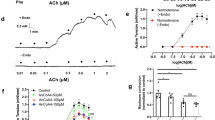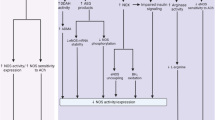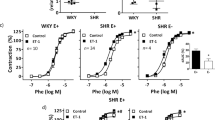Abstract
In human essential hypertension (EH), endothelium-dependent relaxation can occur independent of nitric oxide (NO) and prostacyclin (PGI2). Recent in vivo data suggest that rapid compensatory upregulation of endothelial cytochrome P450 epoxygenase 2C9 occurs to preserve vasorelaxation under conditions of decreased NO bioavailability. As one of the vascular actions of CYP2C9 is to modulate small and intermediate conductance endothelial calcium-activated potassium channels (SKCa and IKCa), we examined whether endothelium-dependent relaxation is sensitive to inhibitors of these channels (apamin and charybdotoxin) in resistance-sized vessels from human with EH. Subcutaneous gluteal biopsies were performed on 12 humans with EH and 12 matched control subjects. Resistance arteries were dissected and relaxation responses to carbachol were assessed ex vivo using wire myography in the presence of: (i) NG-nitro-L-arginine (L-NOARG)/indomethacin; and (ii) apamin/charybdotoxin. Maximal carbachol relaxation was impaired in EH vs control subjects. No differences in responses were observed with the endothelium-independent agonist, S-nitroso-N-acetyl-penicillamine. Relaxation to carbachol was attenuated following incubation with L-NOARG/indomethacin in vessels from control subjects (P<0.01 analysis of variance (ANOVA)), but not in vessels from patients with EH. The reverse pattern was seen following apamin/charybdotoxin with carbachol relaxation attenuated only in EH vessels (P<0.001 ANOVA). Endothelium-dependent relaxation is resistant to endothelial nitric oxide synthase inhibition but sensitive to blockade of calcium-activated potassium channels in human EH. Studies with more specific inhibitors are required to determine whether this response is mediated by endothelial potassium channel subtypes (SKCa and IKCa).
This is a preview of subscription content, access via your institution
Access options
Subscribe to this journal
Receive 12 digital issues and online access to articles
$119.00 per year
only $9.92 per issue
Buy this article
- Purchase on Springer Link
- Instant access to full article PDF
Prices may be subject to local taxes which are calculated during checkout



Similar content being viewed by others
Abbreviations
- BKCa:
-
large conductance calcium-activated potassium channels
- COX:
-
cyclooxygenase
- CYP2C9:
-
cytochrome P450 epoxygenase 2C9
- EDHF:
-
endothelium-derived hyperpolarising factor
- eNOS:
-
endothelial nitric oxide synthase
- 11,12 EET:
-
11,12 epoxyeicosatrienoic acids
- IKCa:
-
intermediate conductance calcium-activated potassium channels
- NE:
-
norepinephrine
- NO:
-
nitric oxide
- L-NOARG:
-
NG-nitro-L-arginine
- PGI2:
-
prostacyclin
- SKCa:
-
small conductance calcium-activated potassium channels
- SNAP:
-
S-nitroso-N-acetyl-penicillamine
References
Feletou M, Vanhoutte PM . Endothelial dysfunction: a multifaceted disorder. Am J Physiol 2006; 291: H985–H1002.
Panza JA, Quyyumi AA, Brush JE, Epstein SE . Abnormal endothelium-dependent vascular relaxation in patients with essential hypertension. N Engl J Med 1990; 323: 22–27.
Taddei S, Virdis A, Mattei P, Ghiadoni L, Gennari A, Fasolo C et al. Aging and endothelial function in normotensive subjects and patients with essential hypertension. Circulation 1995; 91: 1981–1987.
Park JB, Charbonneau F, Schiffrin EL . Correlation of endothelial function in large and small arteries in human essential hypertension. J Hypertens 2001; 19: 415–420.
Cockcroft JR, Chowienczyk PJ, Benjamin N, Ritter JM . Preserved endothelium-dependent vasodilatation in patients with essential hypertension. N Engl J Med 1994; 330: 1036–1040.
Schofield I, Malik R, Izzard A Austin C, Heagerty A . Vascular structural and functional changes in type 2 diabetes mellitus: evidence for the roles of abnormal myogenic responsiveness and dyslipidemia. Circulation 2002; 106: 3037–3043.
Taddei S, Ghiadoni L, Virdis A, Buralli S, Salvetti A . Vasodilation to bradykinin is mediated by an ouabain-sensitive pathway as a compensatory mechanism for impaired nitric oxide availability in essential hypertensive patients. Circulation 1999; 100: 1400–1405.
Halcox JP, Narayanan S, Cramer-Joyce L, Mincemoyer R, Quyyumi AA . Characterization of endothelium-derived hyperpolarizing factor in the human forearm microcirculation. Am J Physiol 2001; 208: H2470–H2477.
Taddei S, Versari D, Cipriano A, Ghiadoni L, Galetta F, Franzoni F et al. Identification of a cytochrome P450 2C9-derived endothelium-derived hyperpolarizing factor in essential hypertensive patients. J Am Coll Cardiol 2006; 48: 508–515.
Edwards G, Dora KA, Gardener MJ, Garland CJ, Weston AH . K+ is an endothelium-derived hyperpolarizing factor in rat arteries. Nature 1998; 396: 269–272.
Griffith TM, Chaytor AT, Taylor HJ, Giddings BD, Edwards DH . cAMP facilitates EDHF-type relaxations in conduit arteries by enhancing electrotonic conduction via gap junctions. Proc Natl Acad Sci 2002; 99: 6392–6397.
Campbell WB, Gebremedhin D, Pratt PF, Harder DR . Identification of epoxyeicosatrienoic acids as endothelium-derived hyperpolarizing factors. Circ Res 1996; 78: 415–423.
Fisslthaler B, Popp R, Kiss L, Potente M, Harder DR, Fleming I et al. Cytochrome P450 2C is an EDHF synthase in coronary arteries. Nature 1999; 401: 493–497.
Matoba T, Shimokawa H, Nakashima M, Hirakawa Y, Mukai Y, Hirano K et al. Hydrogen peroxide is an endothelium-derived hyperpolarizing factor in mice. J Clin Invest 2000; 106: 1521–1530.
Matoba T, Shimokawa H, Kubota H, Morikawa K, Fujiki T, Kunihiro I et al. Hydrogen peroxide is an endothelium-derived hyperpolarizing factor in human mesenteric arteries. Biochem Biophys Res Commun 2002; 290: 909–913.
Rummery NM, Hill CE . Vascular gap junctions and implications for hypertension. Clin Exp Pharmacol Physiol 2004; 31: 659–667.
Shimokawa H, Yasutake H, Fujii K, Owada MK, Nakaike R, Fukumoto Y et al. The importance of the hyperpolarizing mechanism increases as the vessel size decreases in endothelium-dependent relaxations in rat mesenteric circulation. J Cardiovasc Pharmacol 1996; 28: 703–711.
Brandes RP, Schmitz-Winnenthal FH, Félétou M, Gödecke A, Huang PL, Vanhoutte P et al. An endothelium-derived hyperpolarizing factor distinct from NO and prostacyclin is a major endothelium-dependent vasodilator in resistance vessels of wild-type and endothelial NO synthase knockout mice. Proc Natl Acad Sci 2000; 97: 9747–9752.
Scotland RS, Chauhan S, Vallance PJ, Ahluwalia A . An endothelium-derived hyperpolarizing factor-like factor moderates myogenic constriction of mesenteric resistance arteries in the absence of endothelial nitric oxide synthase-derived nitric oxide. Hypertension 2001; 38: 833–839.
Félétou M, Vanhoutte PM . Endothelium-derived hyperpolarizing factor: where are we now? Arterioscler Thromb Vac Biol 2006; 26: 1215–1225.
Fleming I, Busse R . Endothelium-derived epoxyeicosatrienoic acids and vascular function. Hypertension 2006; 47: 629–633.
Chobanian AV, Bakris GL, Black HR, Cushman WC, Green LA et al. Seventh report of the Joint National Committee on Prevention, Detection, Evaluation, and Treatment of High Blood Pressure. Hypertension 2003; 42: 1206–1252.
World Medical Association Declaration of Helsinki. Recommendations guiding physicians in biomedical research involving human subjects. Cardiovasc Res 1997; 35: 2–3.
Aalkjaer C, Pedersen EB, Danielsen H, Fjeldborg O, Jespersen B, Kjaer T et al. Morphological and functional characteristics of isolated resistance vessels in advanced uraemia. Clin Sci 1986; 71: 657–663.
Mulvany MJ, Harpen W . Contractile properties of small arterial resistance vessels in spontaneously hypertensive and normotensive rats. Circ Res 1977; 41: 19–26.
Petrie MC, Padmanabhan N, McDonald JE, Hillier C, Connell JM, McMurray JJ . Angiotensin converting enzyme (ACE) and non-ACE dependent angiotensin II generation in resistance arteries from patients with heart failure and coronary heart disease. J Am Coll Cardiol 2001; 37: 1056–1061.
Fichtlscherer S, Dimmeler S, Breuer S, Busse R, Zeiher AM, Fleming I . Inhibition of cytochrome P450 2C9 improves endothelium-dependent, nitric oxide-mediated vasodilatation in patients with coronary artery disease. Circulation 2004; 109: 178–183.
Scotland RS, Madhani M, Chauhan S, Moncada S, Andresen J, Nilsson H et al. Investigation of vascular responses in endothelial nitric oxide synthase/cyclooxygenase-1 double-knockout mice: key role for endothelium-derived hyperpolarizing factor in the regulation of blood pressure in vivo. Circulation 2005; 111: 796–803.
Thollon C, Fournet-Bourguignon MP, Saboureau D, Lesage L, Reure H, Vanhoutte P et al. Consequences of reduced production of NO on vascular reactivity of porcine coronary arteries after angioplasty: importance of EDHF. Br J Pharmacol 2002; 136: 1153–1161.
Sainsbury CA, Sattar N, Connell JM, Hillier C, Petrie JR . Non-esterified fatty acids impair endothelium-dependent vasodilation in rat mesenteric resistance vessels. Clin Sci 2004; 107: 625–629.
Kernohan AFB, Sattar N, Cleland SJ, Small M, Lumsden MA, Connell JMC et al. Low dose continuous combined HRT and vascular function in women with type 2 diabetes. Diab Vasc Dis Res 2004; 1: 82–88.
Acknowledgements
Dr Sainsbury was supported at the time of this work by a fellowship from the Hypertension Trust of the British Hypertension Society.
Author information
Authors and Affiliations
Corresponding author
Rights and permissions
About this article
Cite this article
Sainsbury, C., Coleman, J., Brady, A. et al. Endothelium-dependent relaxation is resistant to inhibition of nitric oxide synthesis, but sensitive to blockade of calcium-activated potassium channels in essential hypertension. J Hum Hypertens 21, 808–814 (2007). https://doi.org/10.1038/sj.jhh.1002226
Received:
Revised:
Accepted:
Published:
Issue Date:
DOI: https://doi.org/10.1038/sj.jhh.1002226
Keywords
This article is cited by
-
Intravital microscopy reveals endothelial dysfunction in resistance arterioles in Angiotensin II-induced hypertension
Hypertension Research (2012)
-
Effects of vascular risk factors on balance assessed by computerized posturography in the elderly
Aging Clinical and Experimental Research (2009)



